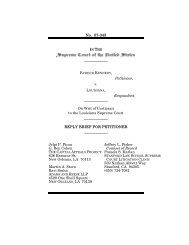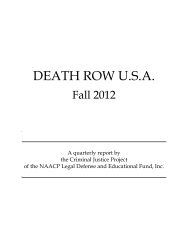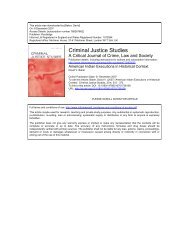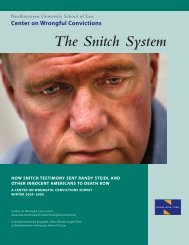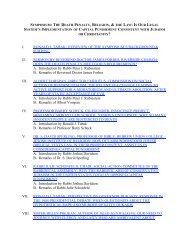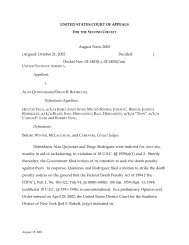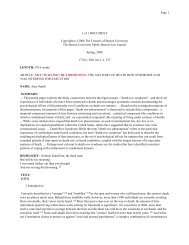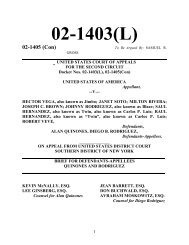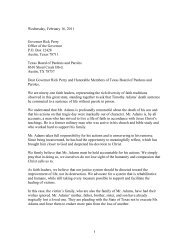Double Tragedies - Families for Human Rights
Double Tragedies - Families for Human Rights
Double Tragedies - Families for Human Rights
- No tags were found...
You also want an ePaper? Increase the reach of your titles
YUMPU automatically turns print PDFs into web optimized ePapers that Google loves.
LOIS AND KEN ROBISON’S son, Larry, was executed in Texas in 2000after being convicted of the murders of five people. Larry had previously beendiagnosed with paranoid schizophrenia. In her public statement at the launchof the NAMI/MVFHR “Prevention, Not Execution” project, Lois said,“We were horrified, and terribly distressed <strong>for</strong> the victims and their families.We thought Larry would finally be committed to a mental institution,probably <strong>for</strong> life. We were wrong. Despite his medical history, he was foundsane, guilty and sentenced to death. How can a modern, civilized society chooseto exterminate its mentally ill citizens rather than treat them? When I was invitedby MVFHR and NAMI to participate in the project that we are embarkingon today, I said, ‘I’ve been waiting 25 years <strong>for</strong> this.’ I have been waiting <strong>for</strong> people to cometogether and say that the death penalty is not the answer to the problem of untreated mental illnessin our country.”At just this juncture, a new doctor took over at that hospitaland – influenced, Joe believes, by pressure from patientadvocates - downgraded the assessment from “high risk” to“moderate risk.” Willy was released in April 2006, unmedicated,and two months later, alone with his mother, he useda hatchet to take her life. Joe was the one who found her,and he “knew immediately that Willy had done it.”Willy was found not guilty by reason of insanity andremanded to a psychiatric hospital, where he is a patienttoday. “Now that he is getting the treatment he should havegotten back in 2005,” Joe reports, “he has a long way to gobut he has not been in a state of psychosis <strong>for</strong> months andmonths. He is doing well, but his life is ruined. He has adeep awareness of what happened. He has to live with whathe did.” 10Living in Maine, a state that does not have the deathpenalty, the Bruces did not directly face the threat of a deathsentence, but Joe is able to imagine the way that such an outhearingat which a judge would decide about the need <strong>for</strong>longer-term commitment, “the hospital lawyer called thepsychiatrist who said we’re not going to send him [to thehearing], we don’t think we have a case.” Joe continues:We were flabbergasted. We said, “You’ve got to bekidding – a couple of weeks ago he almost shot twoguys to death.” They said “Yes, but that was then,this is now.” Their interpretation of the law wasthat he had to be an imminent threat to himself orsomeone else. They said, “Well, he’s on medicationnow; how can we honestly go be<strong>for</strong>e a judge and saythat he’s a threat?” But they also said, “As soon aswe let him out of here, he’ll go off his meds.” I go,“Well, isn’t it logical to argue that if he goes off hismeds there’s a good chance that he’s going to be animminent threat to himself or someone else?” Theysaid, “Sorry, Mr. Bruce, there’s nothing we can do.”Released from the hospital, Willy “got worse and worse– it started getting really scary.” Joe left <strong>for</strong> work every dayworried about Amy. After Willy attacked his father, whoagain called the Crisis Line, Willy was committed to anothermental hospital, where he stayed <strong>for</strong> three months. He wasreleased back to his parents’ home and at that point he was,in Joe’s words, “the worst he’d ever been – we had never seenanything like it. He was completely psychotic by this point.People in town were locking their doors.” Joe remembers hisincreasing panic and helplessness: “I had told the doctor at[the first hospital], ‘He is going to hurt or kill someone, andin all likelihood it is going to be her,’ and I pointed at Amy.”Joe and Amy’s frustration increased tremendouslywhen they were prohibited from receiving any in<strong>for</strong>mationabout Willy’s treatment. They later learned that patientadvocates had persuaded Willy that his parents wereworking against his own interests and that he should cutthem out of his treatment. Only much later, after Joe’sworst fears had been realized, did he get access to Willy’s__ 13 __medical records, where he learned that[the doctor] whom Willy had during his commitmentrepeatedly stated in his progress notes, “Thisyoung man is a high risk <strong>for</strong> violent behavior if releasedinto the community without pharmacotherapy.”He was so concerned about it that he more orless said in his last notes, “Don’t drop the ball onthis.” He wrote that Willy has a pattern of concealinghis illness but is a serious threat <strong>for</strong> violentbehavior if released without medication.10In April 2009, William submitted written testimony to Maine lawmakers insupport of a bill that would provide Assisted Outpatient Treatment (AOT).He opens the letter by explaining that he is in a psychiatric facility because hekilled his mother, and then he writes, “I have been living in sorrow since.”William then goes on to summarize the events leading up to his mother’s murder:“Be<strong>for</strong>e the crime happened I was hospitalized but I refused medication. IfI had been on medication and in an outpatient treatment program I would notbe writing you this letter today. I struggle with this on a daily basis. At thetime everything seemed clear to me. I was a clandestine operative and I believedmy mother was an Al Qaeda operative and I was being ordered to kill her.I did not realize how distorted my mind was and how much the delusions hadtaken over. My dad tells me everyone could see there was something wrongwith me but I couldn’t. This is when I should have been treated.”




